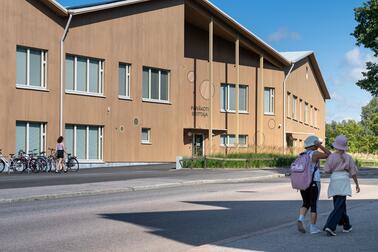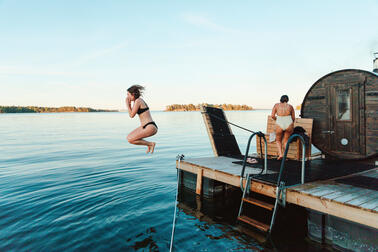
The Baltic Sea Action Plan of the City of Helsinki is making good progress despite the pandemic. The plan includes 111 water protection measure for Helsinki over the 2019−2023 period, and out of these, 81 have already been initiated and eight completed.
Littering control, environmentally friendly boating and the development of partnerships and networks were the actions to make most progress last year. Some of the measures are of a continuous nature.
“The fact that the City is able to advance the targets of its action plan despite the pandemic clearly shows Helsinki’s commitment towards a healthier Baltic Sea. We will not give up in the face of adversity,” says Esa
Nikunen, Head of Environmental Affairs at the City of Helsinki.
Prevention of eutrophication being established
At the end of 2020, 18 of the 25 actions aimed at reducing the nutrient load were either ongoing or initiated. The initiated actions were related to wastewater overflow management, traffic, nutrient removal and studying the impact of agriculture on waters.
There was a new initiative to promote electronic waterway transport, an idea derived through participatory budgeting and implemented thanks to the maritime strategy and Forum Virium. The actions related to agriculture and green area maintenance are of a continuous nature.
At the end of 2020, 14 of the 18 actions related to littering, harmful substances and noise were either initiated or ongoing and two were completed.
The speedy experiments of the Baltic Sea challenge promoted littering control: businesses examined the possibility of filtering out road traffic microplastic from stormwaters with a green wall, the use of a new kind of waste collection vessel in the sea areas of Helsinki, the usability of plastic waste collected from the shores for the production of SUP boards with a 3D printer, and the amount of plastic that ends up in the food waste generated by passenger ship traffic.
The supplemental training for eco-supporters concerning harmful substances and the industrial wastewater risk management package developed through international cooperation (the BEST project) were completed.
Towards clean and safe water traffic
Nine of the 12 actions related to clean and safe water traffic were ongoing and two were completed. Environment-based price incentives for ship traffic were developed further, and the extension of shore-side electricity investments and the utilisation of new ship traffic waste fractions were prepared.
Preparations for the construction of a hull washer were started, and harmful substances at small dockyards were investigated. Nation-wide campaigns on harmful substances and underwater noise were organised for boat clubs. The maintenance of the preparedness for marine oil spill control and the development of the management of incidents in small waters are now continuous activities based on developments.
A campaign for mapping sensitive underwater marine nature in the sea areas of Helsinki was planned (Marine Nature 2021) under the leadership of the Finnish Environment Institute. Marine nature restoration experiments were prepared with the Finnish Forestry Agency (Metsähallitus).
Sustainable use of the archipelago and acknowledging sustainability in consumption were advanced e.g. through the Urban Eco Islands project. Sustainable travel was developed e.g. through the principles of sustainable travel, the Biennial Eco Compass system and through the Port of Helsinki’s Sustainable Travel Finland certificate.
City wants to protect the Baltic Sea actively
An important part of the Baltic Sea Action Plan is to support and develop the partner network of the Baltic Sea challenge. At the end of 2020, the network included 315 organisations. They are committed to exceeding their obligations in protecting their nearby waters and the Baltic Sea.
31 of the 44 actions related to active Baltic Sea citizenship were initiated or ongoing, and three of them were completed. Regarding communications and networking, the implemented actions include the activation of the Baltic Sea Challenge partner network both in Finland and internationally, and the development of the Local Baltic Sea Panel together with the University of Helsinki.
Business cooperation was also advanced through agile experiments and the maritime strategy. In order to increase general awareness, the city participated in campaigns on littering and stormwater drainage into waterways. Community programmes were implemented for young people through the SATAKOLKYT project and the Baltic Sea Day. Cooperation was developed with the cities of Tallinn and St. Petersburg, and the international dissemination of good practices was also promoted through cooperation within the BSR WATER programme.
Background of the Baltic Sea challenge and action plan
The Baltic Sea Challenge was launched by the Cities of Helsinki and Turku who also commit themselves to implementing programmes for the protection of waters on a wide scale.
In autumn 2018, the City Boards of Helsinki and Turku approved the third Baltic Sea Action Plan for 2019–2023. There are five goals: clear coastal waters, a healthy marine ecosystem, clean and safe water traffic, systematic water area management and active Baltic Sea citizenship.
Climate change makes the protection of the Baltic Sea more complicated. The Action Plan increasingly considers the extra stress on the Baltic Sea and particularly on coastal waters brought about by the changing climate, as well as the other strategies and programmes of the City, such as the City Strategy, the carbon-neutral Helsinki action plan, the stormwater programme and the maritime strategy.
The Action Plan is implemented by the Urban Environment Division, the City Executive Office, the Culture and Leisure Division, the Education Division, the Port of Helsinki and the Helsinki Region Environmental Services Authority (HSY). The City’s internal Baltic Sea Challenge working group also includes representatives of Helsinki City Construction Services (Stara), the Helsinki Rescue Department and the University of Helsinki.
Additional information:
Achievements of the local Baltic Sea Action Plan of Helsinki and Turku in 2019−2023.
Status of measures in the end of 2020(Link leads to external service)
(pdf)
The Baltic Sea Action Plan 2019−2023 of Helsinki and Turku(Link leads to external service) (pdf)
The Baltic Sea Challenge(Link leads to external service)
Photo: Marianne Saviaho.


